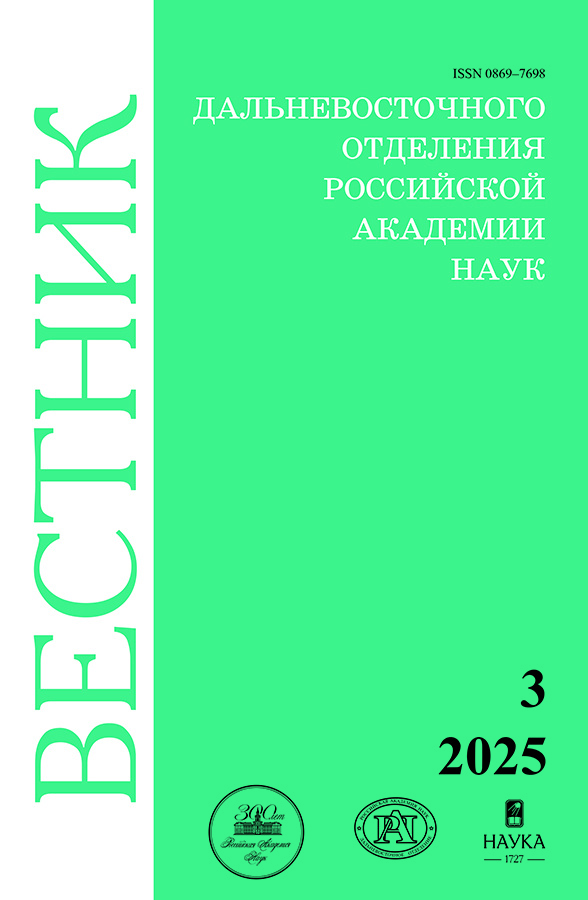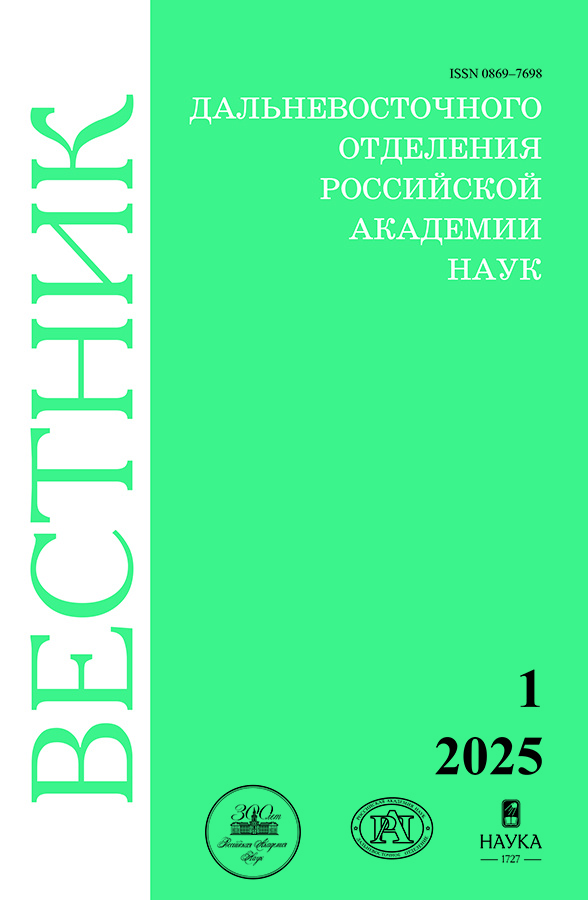Marine invertebrate lectins: isolation, properties and biological activity
- Authors: Chikalovets I.V.1, Mizgina T.O.1, Filshtein A.P.1, Kuzmich A.S.1, Chernikov O.V.1
-
Affiliations:
- Elyakov Pacific Institute of Bioorganic Chemistry of FEB RAS
- Issue: No 1 (2025)
- Pages: 104-119
- Section: Chemical Sciences
- URL: https://archivog.com/0869-7698/article/view/688891
- DOI: https://doi.org/10.31857/S0869769825010079
- EDN: https://elibrary.ru/HHLICW
- ID: 688891
Cite item
Full Text
Abstract
Interest in marine organisms is due to the high content of biologically active substances in them, which are objects of fundamental and applied biomedical research and are effective in the development of therapeutic and prophylactic agents against a wide range of diseases. The laboratory of chemistry of non-infectious immunity of PIBOC FEB RAS conducts research on the screening, isolation, structure determination, study of physicochemical properties and biological activity of lectins from marine invertebrates. Lectins of different carbohydrate specificity have been isolated from bivalve mollusks, the physiological role of which is to participate in the innate immunity of mollusks. These proteins have different biological activity, including antibacterial and antiproliferative.
Keywords
Full Text
About the authors
Irina V. Chikalovets
Elyakov Pacific Institute of Bioorganic Chemistry of FEB RAS
Author for correspondence.
Email: ivchik6@mail.ru
ORCID iD: 0000-0001-5102-9311
Candidate of Sciences in Chemistry, Senior Researcher
Russian Federation, VladivostokTatyana O. Mizgina
Elyakov Pacific Institute of Bioorganic Chemistry of FEB RAS
Email: tanya.tasha@mail.ru
ORCID iD: 0000-0002-9587-897X
Candidate of Sciences in Chemistry, Junior Researcher
Russian Federation, VladivostokAlina P. Filshtein
Elyakov Pacific Institute of Bioorganic Chemistry of FEB RAS
Email: alishichka@mail.ru
ORCID iD: 0009-0000-6293-6582
Candidate of Sciences in Chemistry, Junior Researcher
Russian Federation, VladivostokAlexandra S. Kuzmich
Elyakov Pacific Institute of Bioorganic Chemistry of FEB RAS
Email: assavina@mail.ru
ORCID iD: 0000-0001-5358-5880
Researcher
Russian Federation, VladivostokOleg V. Chernikov
Elyakov Pacific Institute of Bioorganic Chemistry of FEB RAS
Email: chernikov@piboc.dvo.ru
ORCID iD: 0000-0002-3076-3637
Candidate of Sciences in Biology, Deputy Director
Russian Federation, VladivostokReferences
- Freitas A.C., Rodrigues D., Rocha-Santos T.A.P., Gomes A.M.P., Duarte A.C. Marine biotechnology advances towards applications in new functional foods. Biotechnol. Adv. 2012;30(6):1506–1515.
- Ogawa T., Watanabe M., Naganuma T., Muramoto K. Diversified carbohydrate-binding lectins from marine resources. J. Amino Acids. 2011;2011:838914.
- Bonnardel F., Mariethoz J., Salentin S., Robin X., Schroeder M., Perez S., et al. UniLectin3D, a database of carbohydrate binding proteins with curated information on 3D structures and interacting ligands. Nucleic. Acids Res. 2019;47(D1):D1236–D1244.
- Lutaenko K.A., Volvenko I.E. Malyi atlas dvustvorchatykh mollyuskov zaliva Petra Velikogo (Yaponskoe more) = [Small atlas of bivalve mollusks of the Peter the Great Gulf (Sea of Japan)]. 2nd ed. Vladivostok: Dal’nevostochnyi Federal’nyi Universitet; 2022. 138 s. (In Russ.).
- Ahmmed M.K., Bhowmik S., Giteru S.G., Zilani M.N.H., Adadi P., Islam S.S., et al. An Update of lectins from marine organisms: characterization, extraction methodology, and potential biofunctional applications. Mar. Drugs. 2022;20(7). 430.
- Cheung R.C., Wong J.H., Pan W., Chan Y.S., Yin C., Dan X., et al. Marine lectins and their medicinal applications. Appl. Microbiol. Biotechnol. 2015;99(9):3755–3773.
- Chettri D., Boro M., Sarkar L., Verma A.K. Lectins: Biological significance to biotechnological application. Carbohydr. Res. 2021;506. 108367.
- Nascimento Kel.S., Cunha A.I., Nascimento Kyr.S., Cavada B.S., Azevedo A.M., Aires-Barros M.R. An overview of lectins purification strategies. J. Mol. Recognit. 2012;25(11):527–541.
- Belogortseva N.I., Molchanova V.I., Kurika A.V., Skobun A.S., Glazkova V.E. Isolation and characterization of new GalNAc/Gal-specific lectin from the sea mussel Crenomytilus grayanus. Comp. Biochem. Physiol. C. Pharmacol. Toxicol. Endocrinol. 1998;119(1):45–50.
- Chikalovets I.V., Kondrashina A.S., Chernikov O.V., Molchanova V.I., Luk’yanov P.A. Isolation and general characteristics of lectin from the mussel Mytilus trossulus. Chem. Nat. Compd. 2013;48(6):1058–1061.
- Chikalovets I., Filshtein A., Molchanova V., Mizgina T., Lukyanov P., Nedashkovskaya O., et al. Activity dependence of a novel lectin family on structure and carbohydrate-binding properties. Molecules. 2019;25(1). 150.
- Mizgina T.O., Chikalovets I.V., Bulanova T.A., Molchanova V.I., Filshtein A.P., Ziganshin R.H., et al. New L-rhamnose-binding lectin from the bivalve Glycymeris yessoensis: purification, partial structural characterization and antibacterial activity. Mar. Drugs. 2023;22(1). 27.
- Mizgina T.O., Chikalovets I.V., Molchanova V.I., Kokoulin M.S., Filshtein A.P., Sidorin E.V., et al. Lectin of the bivalve Glycymeris yessoensis as a pattern recognition receptor. Russ. J. Bioorganic. Chem. 2020;46(6):1187–1197.
- Mizgina T.O., Chikalovets I.V., Molchanova V.I., Ziganshin R.H., Chernikov O.V. Identification and characterization of a novel lectin from the clam Glycymeris yessoensis and its functional characterization under microbial stimulation and environmental stress. Mar. Drugs. 2021;19(9). 474.
- Wang W., Song X., Wang L., Song L. Pathogen-derived carbohydrate recognition in molluscs immune defense. Int. J. Mol. Sci. 2018;19(3). 721.
- Song L., Wang L., Qiu L., Zhang H. Bivalve immunity. Adv. Exp. Med. Biol. 2010;708:44–65.
- Kovalchuk S.N., Chikalovets I.V., Chernikov O.V., Molchanova V.I., Li W., Rasskazov V.A., et al. CDNA cloning and structural characterization of a lectin from the mussel Crenomytilus grayanus with a unique amino acid sequence and antibacterial activity. Fish Shellfish Immunol. 2013;35(4):1320–1324.
- Chikalovets I.V., Kovalchuk S.N., Litovchenko A.P., Molchanova V.I., Pivkin M.V., Chernikov O.V. A new Gal/GalNAc-specific lectin from the mussel Mytilus trossulus: structure, tissue specificity, antimicrobial and antifungal activity. Fish Shellfish Immunol. 2016;50:27–33.
- Nabi-Afjadi M., Heydari M., Zalpoor H., Arman I., Sadoughi A., Sahami P., et al. Lectins and lectibodies: potential promising antiviral agents. Cell. Mol. Biol. Lett. 2022;27(1). 37.
- Liu Z., Luo Y., Zhou T.-T., Zhang W.-Z. Could plant lectins become promising anti-tumour drugs for causing autophagic cell death? Cell. Prolif. 2013;46(5):509–515.
- Hashim O.H., Jayapalan J.J., Lee C.S. Lectins: an effective tool for screening of potential cancer biomarkers. Peer J. 2017;5(9). e3784.
- Carrizo M.E., Capaldi S., Perduca M., Irazoqui F.J., Nores G.A., Monaco H.L. The antineoplastic lectin of the common edible mushroom (Agaricus bisporus) has two binding sites, each specific for a different configuration at a single epimeric hydroxyl. J. Biol. Chem. 2005;280(11):10614–10623.
- Lorca T., Labbe J.C., Devault A., Fesquet D., Capony J.P., Cavadore J.C., et al. Dephosphorylation of cdc2 on threonine 161 is required for cdc2 kinase inactivation and normal anaphase. EMBO J. 1992;11(7):2381–2390.
- Norbury C., Blow J., Nurse P. Regulatory phosphorylation of the p34cdc2 protein kinase in vertebrates. EMBO J. 1991;10(11):3321–3329.
- Jessus C., Ozon R. Function and regulation of cdc25 protein phosphate through mitosis and meiosis. Prog. Cell. Cycle. Res. 1995;1:215–28.
- Blasina A., Van de Weyer I., Laus M.C., Luyten W.H.M.L., Parker A.E., McGowan C.H. A human homologue of the checkpoint kinase Cds1 directly inhibits Cdc25 phosphatase. Curr. Biol. 1999;9(1):1–10.
- Zeng Y., Forbes K.C., Wu Z., Moreno S., Piwnica-Worms H., Enoch T. Replication checkpoint requires phosphorylation of the phosphatase Cdc25 by Cds1 or Chk1. Nature. 1998;395(6701):507–510.
- Young A.R.J., Narita M., Ferreira M., Kirschner K., Sadaie M., Darot J.F.J., et al. Autophagy mediates the mitotic senescence transition. Genes Dev. 2009;23(7):798–803.
- Chernikov O., Kuzmich A., Chikalovets I., Molchanova V., Hua K.-F. Lectin CGL from the sea mussel Crenomytilus grayanus induces Burkitt’s lymphoma cells death via interaction with surface glycan. Int. J. Biol. Macromol. 2017;104:508–514.
Supplementary files
















